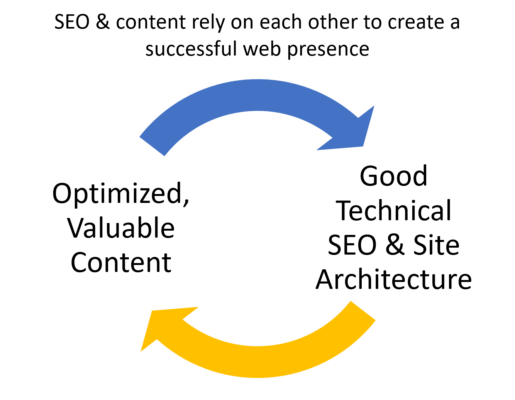Because, in many instances, you're competing against huge name brands with huge budgets and extensive resources available.
It is not necessarily the case that you can't outrank such sites or earn some great links to help you on your approach to doing as such through creative link building; it just requires great effort both in terms of time and resources.
It's rarely – if at any time – a speedy win arrangement when it comes to e-commerce SEO however it continues to be the area where many concentration the greater part of their efforts.
Such a large number of high-ranking SEO guides, including SEJ's Guide to SEO, are basically written for those simply beginning in the realm of SEO.
Newbies are normally the hungriest audiences when it comes to needing to learn something new. There's certainly no holes in embracing such a content strategy, however, things need to be kept simple for such readers. Also, for SEO, simple means repeatedly drumming into the heads of newbie marketers that, to rank a website, it takes great content and great links.
There are a lot more areas of improvements to concentrate on as a SEO, however, especially when hoping to rank an e-commerce store under profoundly commercial terms, and they often provide speedy wins; offering much better opportunities and a better return on time than pursuing yet another link.
Yet, before we dive into the rundown, there are a couple of things that need to be done. These aren't in the fundamental rundown because experienced SEOs should already have these areas covered.
These are, however, now considered to be the rudiments and, in that capacity, something which most SEOs sorted out path back.
If you’re looking for e-commerce SEO quick wins, however, be sure to do the following:
1. Optimize Title Tags & Meta Descriptions for Real People
It is presently more than six years since Panda initially rolled out, five years since Penguin and four years since Hummingbird yet it doesn't take much searching to discover a site with a title tag and meta description which resembles this:
Keywords, keywords, keywords…
Lame, lame, lame.
Improving title labels and meta descriptions thusly doesn't help anyone. They rarely result in top rankings on the SERPs – as Google sees them as over-optimized – and since it looks spammy, users aren't enticed to tap on the posting – further dropping both SERP positions due to a poor CTR .
Unfortunately, an excessive number of e-commerce sites still suffer from such over-improvement, as a rule due to the way that nobody knows well enough to change things or that a certain wave of success has been seen at some point in the past and senior management is excessively apprehensive, making it impossible to alter it.
Always optimize your title tags and meta descriptions for people, not algorithms.
It's people who purchase from you, not computers.
Taking a gander at another example from the same business, here's a site which has been optimized in a substantially more normal manner:
Which result would you click?
In the second example, there's no truncation on the title tag (which clearly outlines what the business offers without being hard to read) and the meta description is used for its fundamental purpose to encourage a searcher to tap on the posting and feature a number of unique selling focuses.
Work through your site's categories, pages, and items and on the off chance that you see titles and descriptions which resemble the primary example, spend some time rewriting based on what people need, not what you were once revealed to Google needs.
2. Discover New Category-Level Keyword Opportunities
There's not at all like a decent piece of keyword research, yet this is something which some
SEO professionals are prone to doing once and forgetting about.
You ought to never quit learning in any stroll of life however it's especially essential when it comes to SEO. The more you can learn about competitors and searchers, the better experience you can serve to users.
A regularly overlooked area of e-commerce SEO is identifying extra category-level keyword opportunities, having perhaps at first conducted keyword research at the time of a new website dispatch, utilizing it to advise of and propose the site's architecture.
Consider how your potential customers are searching for the items which you sell.
It's very easy for a bedding retailer, for example, to run a few core terms through Google's Keyword Planner and see that "pads" is the most searched for term over that side of the business. While there's no denying that, it's a competitive term which will in all likelihood have poor navigate and conversion rates due to being so generic.
It might have volume however will it convert activity into sales? Presumably not.
Hope to break down categories into sub-categories, diving as deep as possible without returning single items. In the example here of a bedding retailer and their cushions collection, you could hope to break down the primary "pads" category into:
- Brands
- Pillow Type
- Filling
- Sleep Position
This could return keywords extending from "pads for back sleepers" through to "hostile to allergy cushions" or even a step further: "hollowfibre against allergy pads."
Ranking for such terms is far easier, due to decreased competition from huge brand retailers, and there's a decent chance you'll see a higher conversion rate due to increased relevancy.
Take the time to review your site's structure against fresh keyword research. Begin by spending time checking out your primary competitors:
- How have they structured sub-categories?
- Are they ranking for any category-level terms which you’ve not optimized for because you hadn’t created a category?
Combine this manual competitor research with search volume information and you'll rapidly discover fresh opportunities to expand your site structure in a way that guides both SEO and user experience.
3. Implement Rich Snippets
In the event that you aren't utilizing rich snippets in e-commerce, you're passing up a major opportunity for a wealth of SEO opportunities.
Would you sooner tap on this:
Or, on the other hand this?
Presumably the first! The result is enhanced in a number of ways, indicating far beyond only a title tag, URL, and meta description, including the price, accessibility, dial shape, model number, and case size.
The second result indicates just the fundamental data seen over every other result.
In the event that you aren't yet utilizing rich snippets to enhance how your results on the SERPs are displayed, you're passing up a great opportunity for the two rankings and revenue.
To note, Google doesn't officially use rich snippets as a ranking component, yet it is widely accepted that natural CTR is no less than an indirect ranking sign. All things considered, in the event that you can improve your CTR through an enhanced result while likewise taking up a larger extent of screen real estate, there is a decent chance better rankings will take action accordingly.
Take the time to become acquainted with the implementation of rich snippets; with the best approach being to learn and understand Schema markup, and how this can be used to increase items.
Likewise read up on Google's Data Highlighter in Search Console and get to feel comfortable around their structured information testing device.
4. Canonicalize or De-Index Thin Content Pages
Would you be able to safely say that your e-commerce store doesn't contain anything which you could regard as "thin" content? No price filters which stack onto their own URL, utilizing their parent category's duplicate, title, and H1 tag?
The larger part of e-commerce stores, depending on their stage of choice, will likely be utilizing filters to improve UX and enable customers to sort items by price, shading, and other variables yet some will be creating a "unique" page alone URL for these.
The same can likewise happen for category pagination. Not necessarily a problem, inasmuch as you're aware and able to take care of them.
The issue? Many forget about them and essentially leave them, potentially opening up problems of keyword cannibalization without realizing so.
One surefire speedy win is to lead a site review which hopes to establish the number of pages in the e-commerce site against those indexed by Google.
Essentially, you're hoping to identify discrepancies here. Use apparatuses, for example, Screaming Frog to run a full slither of the site and compare the number of URLs returned here against that appeared as indexed by Google in Search Console.
Be warned, however, a figure which is higher on your Screaming Frog slither than appeared as indexed by Google is regularly a better scenario than coordinating (or closely coordinating) numbers. Why? Because a higher figure from Screaming Frog more often than not means that the issues have been dealt with. A figure that is the same, however, could mean no problems exist on a little store so dependably use your best sense or burrow a little deeper.
Should you discover large numbers (tens of thousands isn’t unusual) of pages indexed which you know shouldn’t be, you’ve got a quick win opportunity.
The best approach to resolve these issues is to either canonicalize them to the parent category or to de-index using your robots.txt file.
5. Curate ‘Best of’ Guides for Your Top Product Categories
Consider the quick win opportunities of curating “best of” guides for your top product categories to target consumers at the research-stage of their buying cycle.
In almost any industry, you’ll find searches for the likes of “the best pillows for back pain” or “the best shoes for long distance running”. These searches are typically made by those considering making a purchase yet so many e-commerce SEOs overlook the importance of working such content into their strategy.
A great example is Sous Vide Guy’s Best Sous Vide Machines for 2017, a great guide which is relevant and timely (targeted for 2017). It’s visual and it ranks the different products, helping consumers to make decisions. It’s important to note that the site in question here looks to be an affiliate site, however, there’s no reason you can’t do this within your own e-commerce store, hooking in your most relevant products.
If you already have an established store with a strong domain authority, there’s a good chance you’ll see some strong visibility fairly quickly with this approach. Just don’t forget to cover the products within the guide in depth; ideally aiming to cover at least 2,000 words to ensure it’s detailed enough to rank well.
Conclusion:
Always look for your quick win opportunities – too many of your competitors are likely chasing links and working on the time-consuming tasks, putting their focus in those areas. By looking at areas where you can quickly see a return and value from your time, you’re putting yourself in a much better position to grow your
e-commerce store.


























